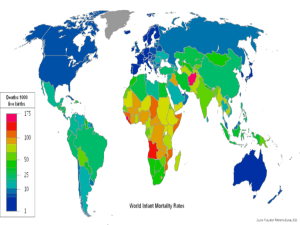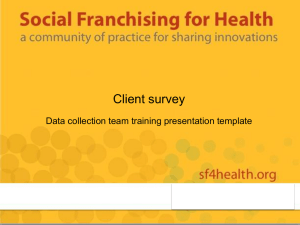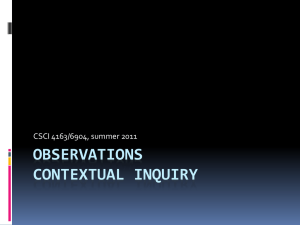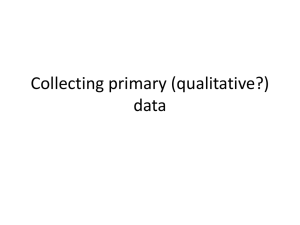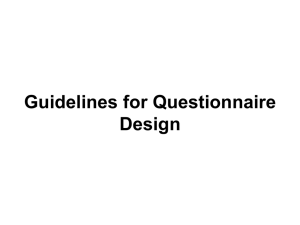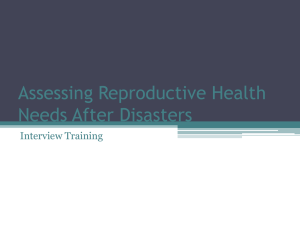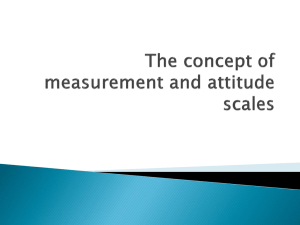Data Collection Method
advertisement
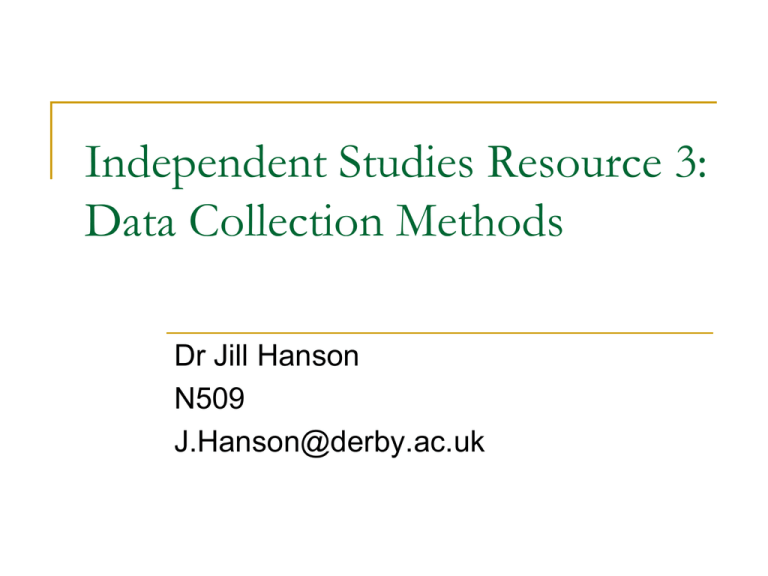
Independent Studies Resource 3: Data Collection Methods Dr Jill Hanson N509 J.Hanson@derby.ac.uk Resource Content Secondary data Observation Interviews Focus groups Questionnaires/tests Learning Outcomes The student should be able to describe and evaluate the main approaches to collecting data The student should be able to decide which collection method will work best for a given research objective Secondary Data Although your project must involve some primary data collection, you can also make use of secondary data. What is secondary data? Documentary data Survey-based data Multiple source data (Saunders et al) Secondary Data Locating secondary data? 1. 2. Availability (e.g. check references to sources of data in articles/books, indexes and catalogues) Actually finding it (Published data – track through reference and then find library that holds it using the ASLIB directory, for in-house data contact information/data manager, can try internet but be mindful of reliability of source) Secondary Data: Advantages and Disadvantages? Advantages? Disadvantages? Evaluating Secondary Data Assess overall suitability 1. Assess precise suitability for analyses required to meet each objective 2. 3. Measurement validity Coverage (including unmeasured variables) Validity and reliability Measurement bias Cost/benefit analysis (in comparison to gathering primary data) Observation “The systematic observation, recording, description, analysis and interpretation of people’s behaviour.” (Saunders et al, 1997, p. 186) Participant observation (qualitative: the meaning of actions) Structured observation (quantitative: the frequency of actions) Observer roles 1. 2. 3. 4. Gill & Johnson (1991) Complete participant Complete Observer Observer as participant Participant as observer Ethical considerations? Data Collection Can take the form of Diaries Informal interview scenarios Could you record these observations? Threats to validity and reliability Good ecological validity but that means less control over confounding variables Observer bias (can be combated using informant verification) Subject error (subjects not truly representative of the norm) Time error (behaviour at time data collected must also be typical) Observer error (subject behaves differently because they are being observed) Types of Interview Structured v Semi-structured v unstructured Standardised v non-standardised Respondent v Informant Threats to Reliability and Validity Reliability of non-standardised interviews (would an interview on another day/with another person yield the same data?) Interviewer bias Response bias Interviewing Skills Opening the interview and developing trust and rapport (don’t start with highly personal/sensitive questions) Asking the right questions (closed v open ended questions, probes) Asking the questions in the right way (to avoid bias – use neutral tone and phrase them clearly) Control your verbal and non-verbal behaviour to reduce bias Active listening Recording the data properly Other Issues To Be Aware Of TIME! Your time (to conduct and transcribe – this takes AGES) The interviewees time (interviews can run into hours of their time – are they likely to be prepared to do this?) Group Interviews (Focus Groups) In a group interview the researcher acts to facilitate and manage the discussion AND the group and the group processes Interview is likely to be unstructured Group dynamic can reveal new themes But can also inhibit shy people Need to manage dominant people and allow everyone to contribute Consider location and setting (promote relaxation so not the managers office) Often useful to have help – 1 facilitates and manages, the other takes notes Questionnaires Applicable with the experiment, quasi-experiments, surveys, case studies and descriptive or explanatory work Efficient way to collect data from a LARGE sample BUT you must ensure it will actually enable you to gather the exact data you actually need before you send it out…(check your data requirements table carefully and make sure you are clear how to analyse it) How To Administer? Face to face Over the telephone Via email Post Questionnaire Design You should not design your own questionnaire unless you absolutely have to! The questionnaire you do use must be shown to be valid and reliable If you write your own you will have to do this BEFORE you collect any data with it (pilot) Therefore usually easier and better to adopt or adapt an existing questionnaire Where would I find such a questionnaire? The questionnaire you use should be based on the theory/model you are using as your theoretical framework. e.g. You are examining the psychological contract and its use as a performance management vehicle. You are using Guest & Conway’s model of the psychological contract Therefore you use Guest and Conway’s questionnaire Look at journal articles to find the printed questionnaire Or maybe contact authors direct Some of these questionnaires are copyrighted/owned by test publishers so you need to pay for them Research Design Requirements Plan carefully What variables you need to measure (independent, dependent and extraneous) What relationships you think might exist What form you want the data to take for each of these variables 1. 2. 3. Ordinal, nominal or interval? Exactly what analyses you will conduct. 4. Influenced by form of data Start with descriptive statistics (and I do not mean pages of pie charts) At Masters you will almost certainly need to conduct inferential statistics as well (but using SPSS makes this quite easy) Return To The Literature Before you put your questionnaire together refer back to the literature What theory are you using as a framework? Usually a theory has a standardised questionnaire which you can use to assess the relevant variables Or what instruments have similar published studies used? Use the same instrument so your findings can be compared to theirs Closed Questions The questionnaire lends itself best to closed questions: 1. 2. 3. 4. 5. Lists (where respondent is offered a list of items, any of which can be selected – but think how you will analyse this kind of data) Categorical (respondent selects one category – reduces accuracy of data) Ranking (respondent ranks choices – again think how you will analyse) Scale (respondent indicates preference on scale e.g. Likert scale – easiest to analyse) Quantity (respondent gives a number) Response Style and Data Forms 1. 2. 3. 4. 5. Lists (nominal data) Categorical (nominal data) Ranking (ordinal data) Scale (interval data) Quantity (interval data) The form your data takes directly controls what kind of analyses you can do. Scale wins every time. Always better to ask participants to rate every category rather than ask them to rank or select Yes/No Response Styles And Analyses Lists and categorical response styles give the least informative data and are most difficult to work with Ranked data also limits the tests you can use but to a lesser extent Scale and quantity data is much richer in nature and easier to work with Recommend using likert response scales (1 to 5 or 1 to 7) rather than check boxes so you can run correlations and regression analyses. Other considerations Font, size and spacing Order and flow of questions (lead them in gradually, warm them up, don’t jump straight to difficult or personal questions) Don’t ask for information if you don’t actually need it (e.g. gender/age – this goes to the ethical considerations of anonymity and confidentiality) Provide definitions of terms so that the respondent interprets your questions in the way you want them to Explicit advice on how they should respond Avoiding common problems in question wording Does your question collect detail at the right level? (check data requirements table) Will respondents have the knowledge required to answer it? Will respondents be familiar with the terminology and interpret it in the way you want them to? Are there any words which might cause offence or will the question cause embarrassment? Can your question be shortened? Are you asking more than question at a time? (don’t) Does your question include a negative or double negative? Is your question unambiguous? (be sure to make it clear what exact response is required) Does your question imply that a certain response is correct? Does your question prevent certain answers from being given? Have you incorporated advice on how to answer each question (e.g. circle a number, tick ONE box etc) Covering Letter A requirement on ethical grounds. Must provide: Who you are Why you are doing the research/who you are representing/why it is important Why respondent is important and how long it will take to complete Promises of confidentiality and anonymity How long/where data will be kept, who will have access to it and what will be done with findings Whom to contact in the event of any queries Right to withdraw at any time/refuse to answer questions Thank you to the respondent Your signature followed by name and title Introducing The Questionnaire Explain clearly and succinctly why you want the respondent to complete the questionnaire Include a clear title and possibly a subtitle Include return name and address at end of questionnaire Pilot Testing Once you have written your questionnaire Ask a small sample of people to complete it Examine their responses to see if they interpreted it in the way you wanted them to and if they answered it correctly Analyse scale data using SPSS to check that your scales measure what they are supposed to Internal consistency Construct validity See why it is easier to use someone else’s? Summary The two most likely data collection methods you will use are Questionnaire Interview (with individuals or groups) Neither are easy to construct You must check them for reliability and validity before you use them with your sample You must ensure that ALL the data you need to collect can be obtained using the method you have devised (refer back to detailed data requirements table)
